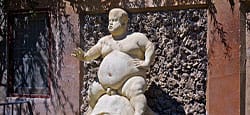With its exceptional size the Pitti Palace is the largest palazzo in Florence. It is really a residence fit for a king, and the imposing architecture has been the model for the principal royal mansions from Vienna to Madrid, from St. Petersburg to Paris. A visit to the Pitti Palace is truly an amazing experience: there are the most beautiful Raphaels and Titians in the world, plus the art objects and furnishings loved and collected by the Medicis. Some of the city’s main museums are based here as well as the magnificent park, the Boboli Gardens, that is the prototype of all Italian-style gardens.
The Pitti Palace has a history that has grown over the centuries and that got its start in the 1400s from the rivalry between two of Florence’s main families: the Pittis and the Medicis. Tradition has it that the rich banker Luca Pitti turned to Brunelleschi and chose a project of his that had been turned down by Cosimo the Elder de’ Medici because of its being too large and costly. Pitti even demanded that the windows of his new palace be wider than the front door of the palace of Cosimo who had, in the meantime, chosen a home that was more sober and less susceptible to inciting envy.
The building began around the middle of the 1400s and the palace became the largest and most opulent of the time. It immediately became the model for every other Renaissance building - and not only in Florence.
However, a century later, the Pitti, burdened with debts, were forced to sell the palace, and in a twist of fate, the mansion was bought by their ancient rivals, the Medicis. Eleonor of Toledo, wife of Cosimo I, had caught tuberculosis and believed that the Pitti residence, situated on the other side of the Arno river, would be healthier than the ducal mansion in the city center, called Palazzo Vecchio (the old palace) from that time on. This began a new phase in the life of the structure: the Medicis made it their sumptuous official residence and hired the architect Bartolomeo Ammannati to complete it and, more than that, to enlarge it. Doubling the depth of the interior volume, the unadorned 15th century palace was transformed into the grandest monumental Florentine palace of the late Renaissance.
The most particular detail added by Ammannati was without doubt the imposing porticoed courtyard. Built during the second half of the 1500s, it was designed as a spectacular vantage point facing the hill and park of the Boboli Gardens in a vast, multi-storey mass of porticoes, balconies and windows.
The courtyard was often host to memorable events like the naval battle fought between twenty Turkish and Christian ships, and for the occasion, was filled with almost two meters of water. Not to mention the celebrated wedding of Ferdinand I de’ Medici and Christine of Lorena, that would go down in history for the ostentation of the festivities.
The spectacular Boboli Gardens, behind the palace, were ordered by the Medicis who personally guided the construction. It is one of the largest and most elegant Italian-style gardens and was conceived as a natural projection of the courtyard designed by Ammannati.
At the end of the 18th century, the Palace passed into the hands of the Lorena dynasty, grand dukes of Tuscany. Two side wings were added to the main building and the interior was redecorated according to the neoclassical tastes of the time. But the main contribution of the Lorenas was, in 1828, organizing and opening to the public the great collection of works contained in the Palatine Gallery, on the second floor of the Palace.
The Palatine Gallery, meaning “of the Palace”, is the greatest collection ever created of paintings from the 17th and 18th centuries. The entire collection is part of the gigantic artistic patrimony owned by the Medicis and not exhibited at the Uffizi, plus numerous later acquisitions.
In its rooms, beneath the sumptuously frescoed Baroque vaulted ceilings, are some of the most famous paintings in the world. The collection includes absolute masterpieces of Italian painting: there are a large number of works by Raphael, some of Titian’s finest, such as the famous Portrait of a Gentleman. And more: well-known works by Caravaggio, Rubens and Van Dyck can be admired along with a body of 17th century Dutch paintings, of particular interest for the rarity and quality of the work.
With the coming of the Reign of Italy, the Pitti Palace became the property of the Savoia, and the second floor was turned into the reception headquarters of the royal family. Their only important architectural contribution was the monumental staircase leading to the Boboli Gardens. Finally, in 1919, the Pitti Palace was donated by king Victor Emanuel III to the Italian state, together with the piazza and the Gardens. After almost four centuries, its function as a royal residence ended.
Today, the Pitti Palace is home to five distinct museums, organized according to different expository themes. Besides the already mentioned Palatine Gallery, the Palace houses the royal Apartments on the second floor, with their sumptuous furnishings and artwork from the three different periods in which the palace was home to the Medicis, the Lorenas and the Savoias. Then there is the Silver Museum, the Porcelain Museum and the Gallery of Modern Art. In the rooms of the smaller Meridiana palace, added in the 19th century, is the Costume Gallery, a most important fashion museum in Italy, that exhibits ancient and modern clothing, accessories and theatrical costumes. In line with this collection, the Pitti Palace hosts “Pitti Moda” every year, the most important Italian fashion event.
Almost five centuries have passed since Luca Pitti ordered the construction of the palace that the Medicis decided to continue calling by the name of its founder; this is confirmation of the fact that it is a living testimony, faithful to history - and not only that of Florence. Entering the Pitti Palace today means not only visiting a museum: it is really total immersion into beauty, an extraordinary voyage that joins history, art and natural wonders into something unique and unforgettable.





